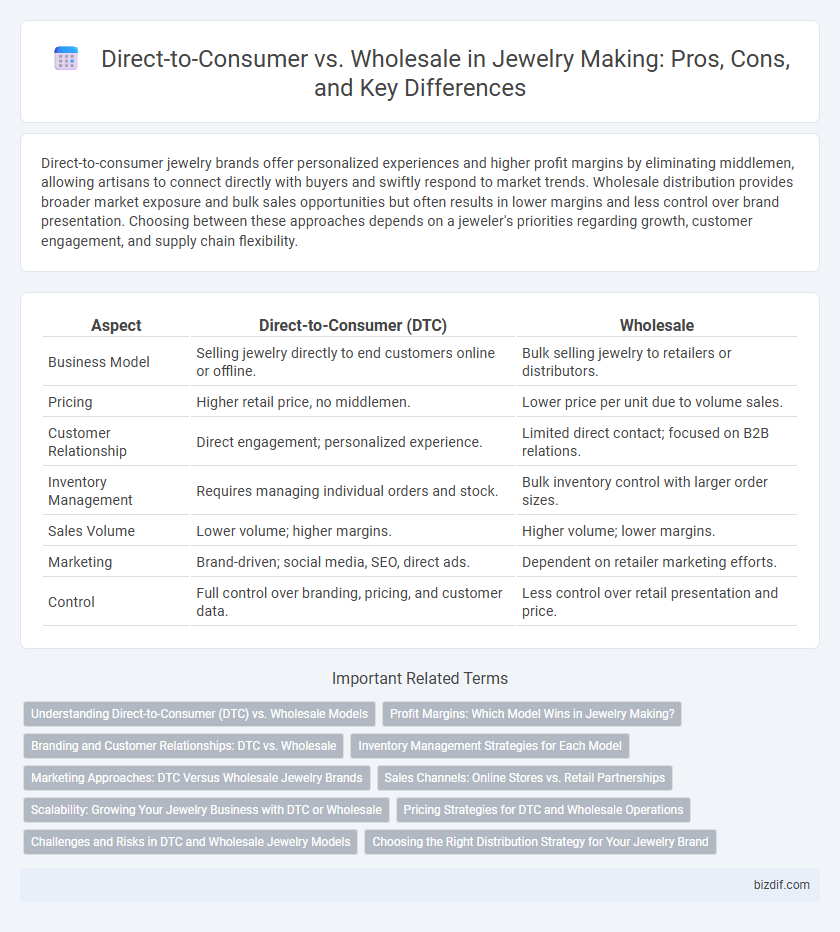Direct-to-consumer jewelry brands offer personalized experiences and higher profit margins by eliminating middlemen, allowing artisans to connect directly with buyers and swiftly respond to market trends. Wholesale distribution provides broader market exposure and bulk sales opportunities but often results in lower margins and less control over brand presentation. Choosing between these approaches depends on a jeweler's priorities regarding growth, customer engagement, and supply chain flexibility.
Table of Comparison
| Aspect | Direct-to-Consumer (DTC) | Wholesale |
|---|---|---|
| Business Model | Selling jewelry directly to end customers online or offline. | Bulk selling jewelry to retailers or distributors. |
| Pricing | Higher retail price, no middlemen. | Lower price per unit due to volume sales. |
| Customer Relationship | Direct engagement; personalized experience. | Limited direct contact; focused on B2B relations. |
| Inventory Management | Requires managing individual orders and stock. | Bulk inventory control with larger order sizes. |
| Sales Volume | Lower volume; higher margins. | Higher volume; lower margins. |
| Marketing | Brand-driven; social media, SEO, direct ads. | Dependent on retailer marketing efforts. |
| Control | Full control over branding, pricing, and customer data. | Less control over retail presentation and price. |
Understanding Direct-to-Consumer (DTC) vs. Wholesale Models
Direct-to-Consumer (DTC) jewelry brands sell products directly through online platforms and physical stores, eliminating intermediaries to offer personalized shopping experiences and higher profit margins. Wholesale models rely on distributing jewelry to retailers or boutiques, leveraging volume sales but often sacrificing control over branding and customer interactions. Understanding these differences helps jewelers optimize pricing strategies, inventory management, and market reach to maximize growth and customer loyalty.
Profit Margins: Which Model Wins in Jewelry Making?
Direct-to-consumer (DTC) jewelry brands typically achieve higher profit margins by eliminating intermediaries, allowing for better price control and stronger customer relationships. Wholesale models involve selling to retailers at a discounted rate, often resulting in slimmer margins but larger sales volumes. In jewelry making, DTC's ability to capture full retail price coupled with lower distribution costs generally leads to superior profitability compared to wholesale.
Branding and Customer Relationships: DTC vs. Wholesale
Direct-to-Consumer (DTC) jewelry brands maintain complete control over branding, enabling personalized storytelling and consistent customer experiences that build strong, direct emotional connections. Wholesale channels often dilute brand identity due to third-party retail involvement, limiting direct interaction with end customers and reducing opportunities for tailored marketing. Strong customer relationships in DTC models drive loyalty and repeat purchases, whereas wholesale focuses on volume and distribution, often sacrificing brand exclusivity and personalized engagement.
Inventory Management Strategies for Each Model
Direct-to-consumer jewelry brands benefit from real-time inventory tracking and limited batch production to reduce overstock and enhance personalization, while wholesale operations prioritize bulk inventory management and demand forecasting to maintain sufficient stock levels across multiple retail partners. Leveraging integrated inventory management software tailored for each model ensures accurate stock visibility and streamlines order fulfillment processes, reducing lead times and minimizing holding costs. Efficient inventory turnover rates and proactive replenishment strategies are critical for both models to balance cash flow and meet market demand.
Marketing Approaches: DTC Versus Wholesale Jewelry Brands
Direct-to-consumer (DTC) jewelry brands prioritize personalized digital marketing strategies, leveraging social media platforms, influencer collaborations, and data-driven customer insights to build direct relationships and enhance brand loyalty. Wholesale jewelry brands rely on B2B marketing channels, trade shows, and retail partnerships to reach broader markets while focusing on volume sales and brand visibility through third-party retailers. The DTC approach enables real-time consumer feedback and agile marketing adjustments, whereas wholesale strategies emphasize large-scale distribution and long-term retailer collaborations.
Sales Channels: Online Stores vs. Retail Partnerships
Direct-to-consumer (D2C) jewelry brands leverage online stores to control branding, pricing, and customer experience, increasing profit margins and gathering valuable consumer data. Wholesale channels, including retail partnerships, expand product reach through established brick-and-mortar stores but often demand lower prices and shared brand control. Online sales channels prioritize digital marketing and direct customer engagement, while retail partnerships require collaboration on visual merchandising and inventory management to maximize in-store sales.
Scalability: Growing Your Jewelry Business with DTC or Wholesale
Direct-to-consumer (DTC) jewelry brands benefit from scalable online platforms that enable rapid customer base growth and higher profit margins by eliminating intermediaries. Wholesale distribution offers scalability through bulk orders and established retailer networks, providing steady revenue but with lower margins and less direct customer engagement. Balancing DTC's personalized marketing strength with wholesale's volume sales potential allows jewelry businesses to optimize growth strategies effectively.
Pricing Strategies for DTC and Wholesale Operations
Direct-to-Consumer (DTC) jewelry brands often implement premium pricing strategies to reflect brand exclusivity and higher profit margins by eliminating intermediaries. Wholesale operations rely on volume-based pricing with significant discounts to retailers, balancing lower per-unit profits against larger order quantities. Optimizing pricing for DTC includes leveraging data analytics on consumer behavior, while wholesale pricing typically emphasizes competitive rates to secure bulk purchase commitments.
Challenges and Risks in DTC and Wholesale Jewelry Models
Direct-to-consumer (DTC) jewelry models face challenges such as high customer acquisition costs, managing personalized customer experiences, and inventory risks due to fluctuating demand. Wholesale jewelry businesses encounter risks including dependency on retailer relationships, lower profit margins, and market saturation that limits brand control and pricing power. Both models require strategic risk management to balance scalability, cash flow stability, and customer engagement.
Choosing the Right Distribution Strategy for Your Jewelry Brand
Selecting the right distribution strategy for your jewelry brand hinges on your target market and profit margins, with Direct-to-Consumer (DTC) offering higher control and greater customer engagement, while Wholesale provides broader market reach and faster inventory turnover. DTC leverages e-commerce platforms and social media marketing to build brand loyalty and capture valuable consumer data, enhancing personalized experiences. Wholesale relies on partnerships with retailers and distributors to scale quickly, but often comes with reduced pricing power and less control over brand presentation.
Direct-to-Consumer vs Wholesale Infographic

 bizdif.com
bizdif.com